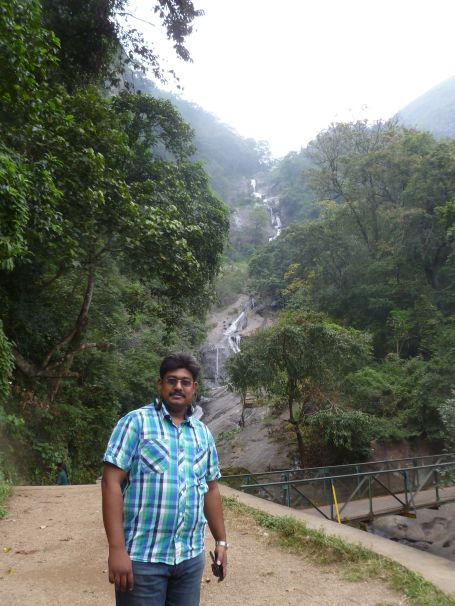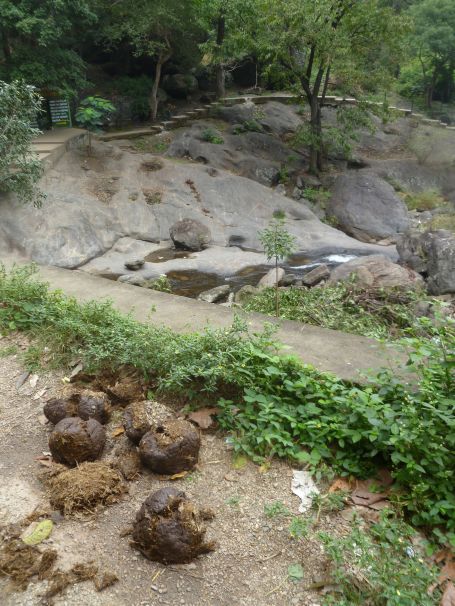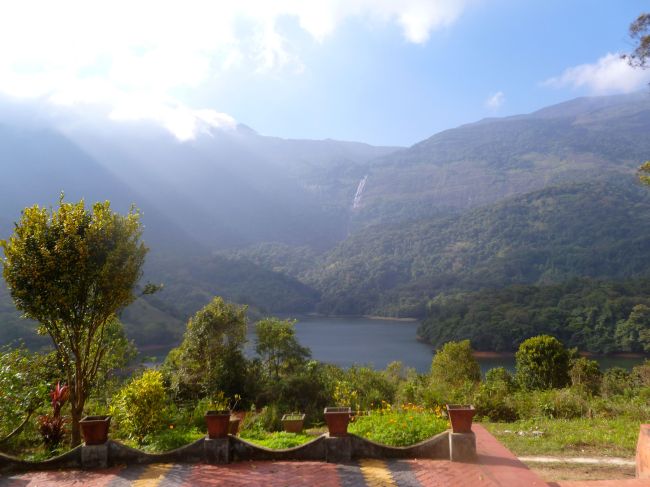Siruvani Falls and Trip to Patiyar
30/12/2013
December 22. Summary: visited Siruvani Falls on outskirts of Coimbatore (under the Tamil Nadu Forest Department), then went to Bharathiar University and had a tour of Dr. Mani’s lab. Loaded a rented 4X4 and traveled through Palakkad to Siruvani Reservoir (unrelated to Siruvani Falls) in a Kerala Reserve Forest. Arrived at Patiyar well after dark.
Arun picked me up at the hotel and we made a run in taxi up to Siruvani Falls a recreation area just outside of Coimbatore city. These are falls on the “Siruvani River” which is really a stream draining the eastern slope of the Siruvani Hills (Western Ghats). I made the mistake of presuming that this was the same Siruvani River of the lake we would be visiting later, which is also named the Siruvani, but it is a different watershed though both eventually flow into the Bhavani and later into the Koveri River that drains into the Bay of Bengal. While these falls pale in comparison to later spots we’d see, there were a couple of observations that I can share.
This is a reserve no more than 30 km outside of the city, and yet there are wild elephants. No, I didn’t see any, but there was plenty of evidence in the form of wild elephant shit. Arun tells me that the elephants move into the area where they eat plants, destroy bamboo and then leave. The man from whom we are hiring the jeep works in a project relating to elephant conservation.
The measures of protection for the area (I’m not sure if it’s a reserve—check later) are pretty remarkable. It’s a pay-to-enter site, which is a bit surprising from my angle, since it turns out it’s only a half-kilometer hike to get to the falls, but people go to have picnics and to dip their feet (or more) in some shallow pools that have been constructed—not under any falls, but in an easily accessible spot close to the falls viewing site. Entering the site is much like entering the secure area of an airport. Bags are searched and bodies frisked, though what they are looking for is not weapons or explosives but rather plastic that might be left as trash. Also disallowed are any form of soaps or shampoos, because people had been using the pools as a bathing area with the result of habitat degradation.
There is a community living in what may be the buffer zone, and while they have been involved in the development of the site it is not the principal steward of the reserve—that would be the Tamil Nadu Department of Forestry.
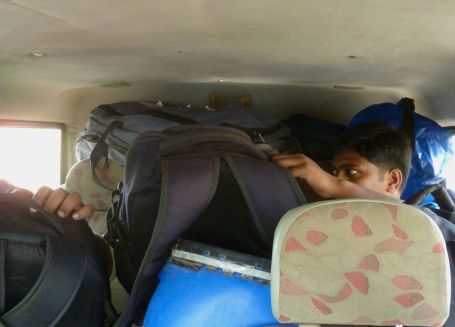
The back of the Jeep (actually a Mahindra 4X4) was totally packed, so we piled more stuff on top of the seated grad students, while the driver and his international guest rode comfortably in front.
We got a late start out of Bharathiar to head to our first real field collection/sampling site, the reserve surrounding the Siruvani reservoir in Kerala, and in a heavily loaded 4X4 with Dr. Mani driving we navigated our way out of Coimbatore to Palakkad and then north into Siruvani. The total distance was not that great, but traffic in inhabited areas is very heavy, and in the spaces in between inhabited areas, the two-lane road is shared by passenger cars, trucks (some are jumbo-sized), farm vehicles, and oxen-pulled haywagons. It seemed almost merciful that those distances between towns were so short, though one realizes how mercilessly dense the population is here that so little space between dense population centers. The relatively short distance traveled just getting to the boundary of the buffer zone—I’d say around 70 km (check later)—took all of three hours. Poor Arun and Magesh were crammed in the back seat with a water barrel between them and luggage on their laps. I carried Dr. Mani’s camera bag on my lap in the passenger seat.
There were four checkpoints to cross between the buffer zone boundary and the Siruvani guest house. The first required some sweet-talking and rank-pulling negotiation on Dr. Mani’s part to be allowed across. Technically no entry is allowed past five o’clock, but there’s a reason he’s called “Sir.” At the second checkpoint there was a sign saying something like “Absolutely no entry,” and starting with the third checkpoint the guard hardly even bothered to check who we were. From checkpoint #4 onward, there was wildlife to be spotted: an Indian Gaur (a very large bovid), two mouse deer, a barking deer, a mongoose, a leopard (yes. A fucking leopard!), a leopard cat. (No, you can’t be jealous yet)
Patiyar is the name of the Siruvani Guest House. It is owned by the Kerala Department of Irrigation and is situated on the end of a headlands jutting into the lake. It was dark when we got in, and when the next morning I woke up to the trumpeting of tusker elephants fighting in the distance, and this view. Yes, now be very jealous. A stay at Patiyar is very difficult to arrange, even for Dr. Mani. It is typically used to host high-level officials who are on holiday.
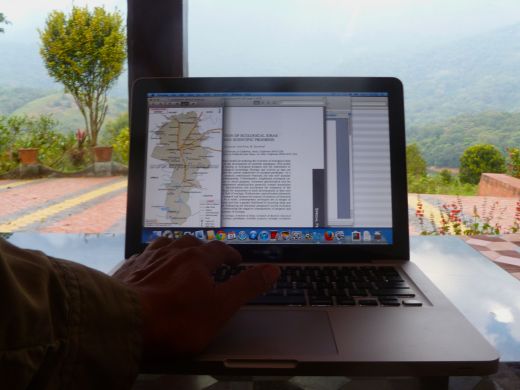
Doing my best to document the events of my trip, which are shaping up as a continual procession of extraordinary experiences.
